This blog offers a direct comparison of interactive classroom, or conference room, projectors from Hitachi and Epson that were reviewed individually a few months ago. The Epson Brightlink 595Wi includes the hardware and software for using either interactive pens or fingers touch for drawing and making on-screen menu selections, while the otherwise similar Epson Brightlink 585Wi supports only the use of interactive pens. The Hitachi CT-TW2503 supports use of (supplied) interactive pens, while offering an add-on accessory, at extra cost, to also enable using finger touch inputs for the interactive features. For this blog, I'll provide a brief comparison of the features and performance of these two projectors, and discuss which offers, in my opinion, the best value.
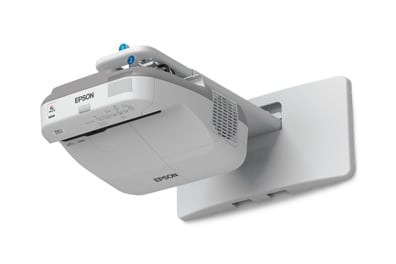
Epson Brightlink 595Wi
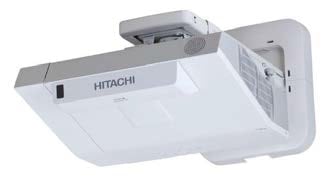
Hitachi CP-TW2503
The
Hitachi CT-TW2503 is shown in the top photo above and the
Epson Brightlink 595Wi is shown in the lower photo above. These are both ultra short throw interactive projectors that will typically be mounted just above a whiteboard for use in a classroom or conference room.
PROJECTOR OVERVIEWS
Except where noted, the following information that refers to the Epson Brightlink 595Wi, also applies to the Epson Brightlink 585Wi, since these two Epson models are very similar other than that latter model not supporting finger touch interactive input.
FEATURE/SPEC........................................HITACHI CT-TW2503............EPSON BRIGHTLINK 595Wi
Street Price* (typical)......................................$1999............................$2399 ($2199**)
Technology....................................................3LCD.............................3LCD
Native Resolution............................................1200 x 800.....................1200 x 800
Brightness.................................................... 2700 lumens...................3300 lumens
Contrast Ratio................................................5000:1...........................10,000:1
Lamp Life......................................................4000 hours.....................4000 hours
Weight.........................................................9.9 lbs............................12.1 lbs. (11.7 lbs**)
Warranty......................................................3 years (lamp: 90 days).....2 years*** (lamp: 90 days)
* Epson offers a substantial Education Discount for schools at well below the listed street prices
** Epson Brightlink 585Wi
*** 3 years when purchased by a qualifying education institution
I should note that Epson offers a lower-end interactive model Brightlink 575Wi that has not been reviewed by Projector Reviews. This lower priced Epson model ($1999 street price) is specified at 2700 lumens, the same as Hitachi's spec. for the CP-TW2503. Since we have not reviewed that lower priced Epson model, I was not able to use it as the basis for a comparison. Also while the street price of the Epson Brightlink 585Wi and 595Wi are a few hundred dollars higher than for the Hitachi CP-TW2503, Epson offers a substantial education discount for schools that lowers the price of these Epson models below $2000. To be fair I must also mention that Hitachi offers a higher lumens version with their model CP-TW3003 that appears have the same features as the CP-TW2503. This more expensive Hitachi model (typical street price is near $2150) has not been reviewed by Projector Review, but is spec'ed with the same 3300 maximum lumens output as the Epson Brightlink 585Wi and 595Wi models. The following sections offer a comparison of the Hitachi and Epson projectors for specific areas of features and performance.
INTERACTIVE CAPABILITIES
Epson Brightlink 595Wi
Epson offers a built-in suite of many annotation tools and other capabilities, but in addition, it supports 3rd party interactive software (and vice versa). This means more than just having a nice collection of tools, but also templates, and in the case of school, even pre-created coursework. Ideally you work interactively with the projector by being up at the screen, and this Epson Brightlink is excellent at that. Pens have been the primary tool for interactive work for more than a decade and the 595Wi come with two of those. The 595Wi is the first Epson projector to add fingertips to the available tools in the interactive arsenal. The Epson system can detect the touch position of up to 6 fingers and this is a big step forward in interactivity for video projection systems. For example, two people could be standing next to the white board/screen with each drawing with different colors, using up to three fingers on one hand, and a pen in the other. These interactive capabilities are not limited to just drawing on the electronic white board, as the fingers/pens can be used to do such things as selecting items from a menu, scrolling pages, resizing or rotating objects, etc. It makes the electronic white board more-or-less act like a giant multi-touch tablet which should make it a lot easier to keep the electronic-age students involved in the classroom learning process.
Epson has on-board software in the projector which allows for all the core interactive functions, to control color, line thickness, highlights, and so much more. You can toggle between pen/touch and mouse modes, between computer free, and interfacing with a computer.
Of particular note, you can save all your annotations if you are in computer mode, a great way to “record” a presentation, or keep classwork to be made available online later.
You can annotate over video, another nice touch. Teachers or presenters can pause a movie, then draw arrows to point out certain aspects of a scene. Perhaps an instructor or presenter might highlight areas that they want the user pay particular attention to when the video starts back up again.
All in all, the 595Wi has a really good collection of tools built into the projector, but the additional downloadable software definitely adds a whole new level of functionality.
I did some testing of the basic interactive features of the 595Wi. First I used one of the light pens (shown in the first photo below) to verified that actual vs. detected point that I touch the tip of the pen to the screen was offset less than 1/2 inch at any of the several locations across the screen surface that I tested.

I used the pen for drawing and also for selecting items from on-screen menus. I found the pen worked reliably for both of these functions. A single tap of the pen on the whiteboard acts as a left mouse button click, two quick taps act as a double click, the button on the side of the pen acts as a right mouse click, and you can also tap and drag objects. I also tested finger touch input for both drawing and for selecting menu items. I found the location accuracy to be at least as good, and perhaps even a little better than the interactive pens with errors less than 1/2 inch from the on-screen position. The description and observations above generally also apply to the Epson Brightlink 585Wi, except it does not support finger touch interactivity.
Hitachi CP-TW2503
The Hitachi CP-TW2503 has on-board software in the projector which allows for all the core interactive functions, to control color, line thickness, highlights, etc. You can use either the supplied interactive pens or the projector’s remote control as a simple mouse.
The CP-TW2503 is supplied with two interactive pens as shown below.
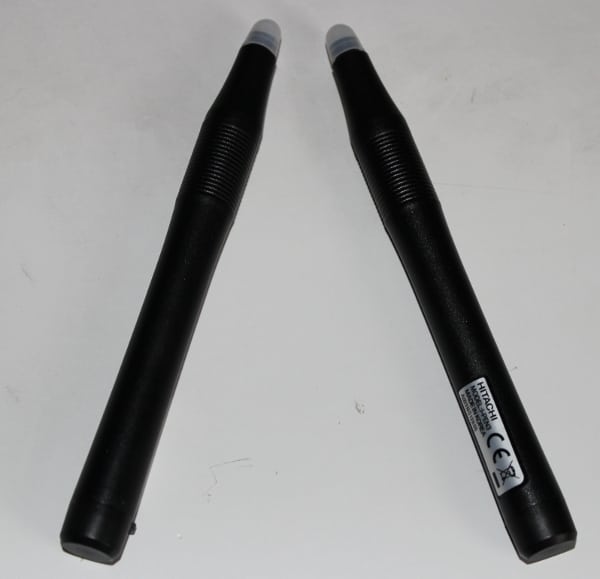
As it typical for such interactive pens, the tip is pressure sensitive and is intended to be pressed against a rigid projection surface, and that’s why a normal fabric screen is not appropriate for use with such interactive projectors, as the screen surface could be damaged. A whiteboard is the most common projection surface for use with an interactive projector and the CP-TW2503 can also be mounted vertically, using an optional table mount, to create an interactive table top when projecting downward onto to a large white table top. The projector has a ‘camera’, or sensor, located right next to the projection lens that is used to calibrate and to track the position of the interactive pens relative to the projected image.
The Hitachi user manual also mentions an optional “Finger Touch Unit” (model FT-01) that can be used with the CP-TW2503, but this optional unit was not supplied with the projector used for my review. With the addition of this extra cost option ($300 to $350 street price) the CP-TW2503 should have similar finger touch interactive functionality as does the Epson Brightlink 595Wi (and also have a similar total street price).
Overall, the CP-TW2503 has a good collection of interactive tools built into the projector, even when the projector is not connected to a computer. When connected to a computer, the interactive functions can be used to control the basic functions of the connected PC.
I found the position accuracy for the interactive pens to be excellent with an error of less than 1/2 inch over the full projected image.
BOTTOM LINE on Interactivity
I found the use of interactive pens to be very similar with both the Hitachi and Epson projectors. Both worked extremely well and both had excellent registration accuracy between the physical position of the pen's tip and the position of the projected image. The Epson Brightlink 595Wi adds finger touch interactive input as a standard feature (absent on Epson 585Wi), but a similar capability can be added to the Hitachi CP-TW2503 with installation of an extra cost accessory. This Hitachi finger touch accessary was not reviewed. However, I would expect, but have not verified, that when it is added to the CP-TW2503 then the interactive capability and performance would be similar to the Epson Brightlink 595Wi. So the bottom line is Epson and Hitachi have both produced projectors with excellent interactive input capabilities and I'm not able to declare either one a clear winner for interactivity.
Picture Quality and Performance
Both the CP-TW2503 and the Brightlink 595Wi offer very good image quality for projecting video, considering these are classroom projectors. With the Epson the most accurate picture mode was "Theater" mode and for the Hitachi it was "Cinema" mode. I set up both projectors and projected the same image from a Blu-ray disc side-by-side onto the same projection screen. Below are screen shots I took for 3 different images from the movie Divergent. The image on the left is from the Epson Brightlink 595Wi and the image on the right is from the Hitachi CP-TW2503. The overall brightness of the Epson is about 16% higher than the Hitachi in Picture Modes used for this evaluation, therefore the image on the left is expected to appear a little brighter than the one on the right in the following photos.



Overall the Epson presented colors that were a little too bright with its default settings while the Hitachi presented colors that were a little too dark with its default settings. With a signal input is YCbCr format, as from the blu-ray disc player I used as the source for the above images, I used the projector's Color adjustment to produce a more correct color level. We do not normally calibrate classroom and business class projectors that we review. However, after checking the performance of these two projectors with their out of the box settings, I made a few adjustments to produce a more accurate grey scale/color balance. The specific adjustments are described in the detailed reviews for these two models. The following two figures show the grey scale for the Epson (upper image) and the Hitachi (lower image) after making the picture adjustments. The Epson had a average color temperature of 6579K and the Hitachi had a average color temperature of 6435K, with both near the ideal 6500K for viewing video.

Epson Brightlink 595Wi - Grey Scale w/adjustments

Hitachi CP-TW2503 - Grey Scale w/adjustments
No attempt was made to made adjustments that might improve the gamma. The measurements for these two characteristics are shown in the images below, first for the Epson then for the Hitachi.
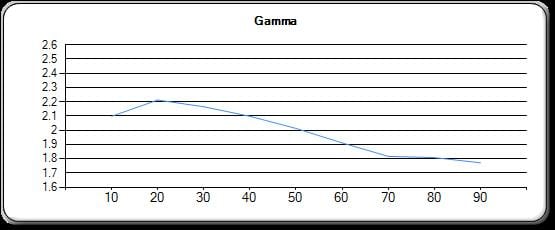
Epson Brightlink 595Wi - Gamma in Theater Mode
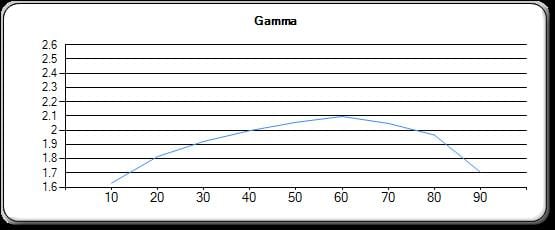
Hitachi CP-TW2503 - Gamma in Cinema Mode
No attempt was made to made adjustments that might improve the color gamut, or chromaticity of the projected image. The measurements for these two characteristics are shown in the images below, first for the Epson then for the Hitachi.
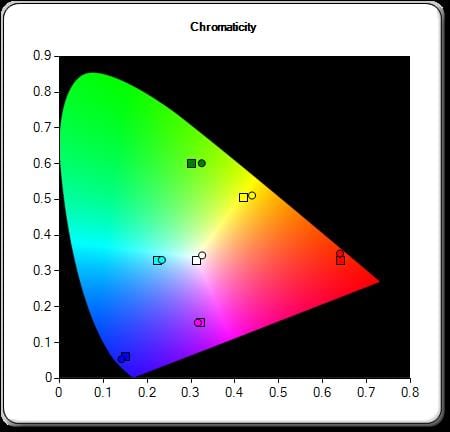
Epson Brightlink 595Wi - Color Gamut in Theater Mode
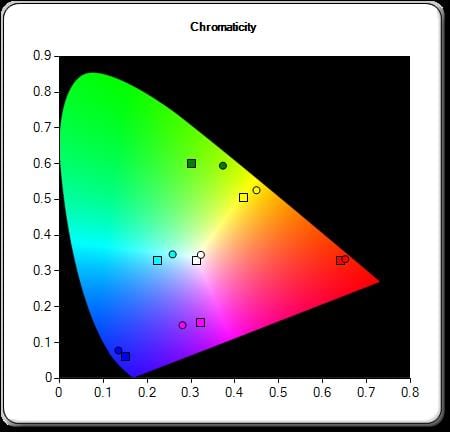
Hitachi CP-TW2503 - Color Gamut in Cinema Mode
Both of these projectors use 3LCD technology, The LCD chips and optics used in business and education class projectors typically results in a rather low contrast image with relatively high black levels. While Epson specs. indicate a 10,000:1 (on/off) contrast ratio and Hitachi indicates a 5,000:1 contrast ratio, these number really do not reflect the true contrast performance of these projectors. This is one area in which DLP based education and business class projectors offer better performance than similar priced 3LCD modes. However, when used in a room with even moderately low room lighting, the advantage all but disappears because the ambient room lighting will light up the screen to the point that dark blacks in the projected images are no longer possible regardless of how good the contrast ratio and black level performance is for the projector. In my very dark room that was used to evaluate the performance of these two projectors, the Epson had a little lower black level and higher contrast ratio as compared to the Hitachi. Both projectors produced excellent image sharpness with good focus over the entire image. The image sharpness with essentially limited by the native 1200 x 800 resolution of both of these projectors.
BOTTOM LINE on Picture Quality and Performance
With a few adjustments both the Epson and Hitachi projectors were able to produce fairly good picture quality with the edge going to the Epson Brightlink 595Wi. The Epson produced more accurate colors and an overall more accurate image. The grey scale tracking from dark grey to full white was a little better on the Epson, as shown in the charts above. The Epson's color gamut was also more accurate which allowed for more accurate colors. While neither projector had very good gamma characteristics, the edge goes to Epson in this area as it also did for black levels and contrast ratio. Image sharpness was excellent on both of these projectors, which is an accomplishment as both of these projectors are ultra-short throw models.
Value
While the Hitachi CP-TW2503 carries a $3000+ list price, its typical street price is in the $2000 range making is a direct competitor to the Epson Brightlink series of projectors. While the Brightlink 595Wi has a street price about $400 higher than the CP-TW2503 and $250 more than the Hitachi CP-TW3003 (with similar lumens output to the Epson), the Epson includes finger touch interactivity while with the Hitachi this requires a $300+ add-on accessory (i.e, making them more comparable pricewise). If you don't need the finger touch interactive feature then Epson's lower priced Brightlink 585Wi or even the Brightlink 575Wi models could be considered. Finally, if the projector is being purchased by a school, Epson offer large education discounts that lowers the price on the Epson models to well under $2000. Both the Hitachi and Epson projectors offer very good performance with the Epson having the edge in term of producing the best image quality with the most accurate colors. While both represent a good value, the Epson Brightlink 595Wi (and 585Wi) scores a little higher in my book by providing both great interactive features combined with very good picture quality at a reasonable price, for this category of projector.
Final Thoughts
This mini-shootout is just that. It only discusses and considers some of the features and performance characteristics of these projectors while the full reviews for the Hitachi CP-TW2503 and Epson Brightlink 595Wi, and 585Wi go into much more details. Also check out Projector Reviews TV (
HERE) for a video review of the Epson Brightlink 585Wi. This mini-shootout considers two projectors that were reviewed after the cutoff date for the publication of the Projector Reviews Report:
The 2014-2015 Classroom Projector Report: The Best Projectors For Schools. Check out that report for more classroom projectors.














